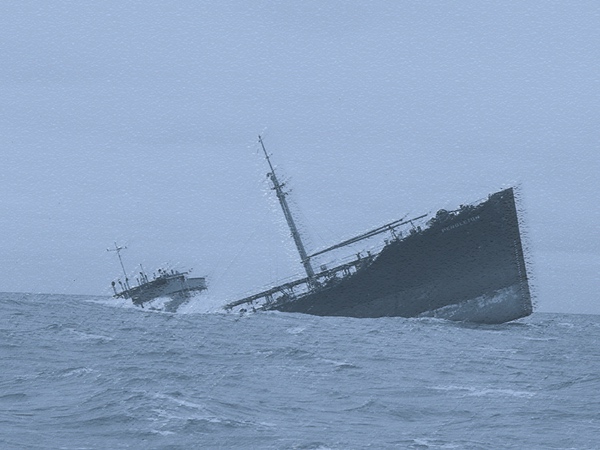Editor’s Note: You can read part 1 of this series here.
America’s Coast Guard has been asked to do many things in its 228-year history, but there is one thing they probably do better than anyone else.
Search and rescue.
On February 18, 1952, a four-man “Coastie” lifeboat crew performed a rescue that enshrined their organization forever in a Rescue Hall of Fame, if there ever is one.
This story has been told among Coasties everywhere for the last 66 years, and also is told in a 2009 book and displayed in a 2016 movie. No Sun Day article or series about Coasties can be published without a description of this incredible lifesaving event, in one of the worst storms ever to hit America’s east coast.

Bow section of Pendleton aground near Pollock Rip Lightship. (Photo provided)
The SS Pendleton was a T2 oil tanker traveling up the Eastern Seaboard from New Orleans to Boston. The Pendleton was built in 1944 and was originally used in troop and supply transportation operations in World War II. It was sold to the National Bulk Carriers organization in 1948. It was an efficient amphibious workhorse, with only one flaw, it was prone to splitting in two in cold weather.
As the vessel approached Boston, a major storm blew up and cracked her in two about 15 miles off Cape Cod, Massachusetts. Eight members of its 41-man crew, including the captain, were lost when the bow section sank quickly. Thirty-two others were trapped on the sinking stern section, and calls for help were sent over a damaged radio.
The Coast Guard dispatched a four-man crew captained by Boatswain’s Mate, First Class Bernard Webber, was dispatched from the Chatham, Massachusetts, CG station on Cape Cod.
Webber’s 12-man lifeboat was damaged going over a sand bar coming out of its harbor, and lost its compass. However, the crew managed to locate the Pendleton’s stern. Webber quickly realized the challenge – his tiny 12-man lifeboat was bouncing up and down in huge waves, and 60-feet above, 32 sailors on the doomed remains of the Pendleton were anxiously waiting.
The only significant tool available was a narrow Jacob’s ladder, a swinging marine rope ladder, similar to those used to transport troops from transports to landing craft in World War II.
Webber carefully maneuvered his craft underneath the listing hull and motored his boat back and forth with the waves, while the Pendleton’s crew lowered themselves down the side on the Jacob’s ladder, one at a time. The crew, timing their descent against the rise and fall of the ocean, jumped from the swaying ladder onto the moving deck of the lifeboat, while Webber carefully kept his boat under the ladder but clear of the towering metal wall of the broken-up Pendleton.
All 32 survivors were saved and taken back to the Chatham station.
Webber and his three crew members were each awarded the Coast Guard’s Lifesaving Medal. The two bow sections of the tanker were eventually sold for recycling. The rescue was the topic of the 2009 book, “The Finest Hours, The True Story Behind the U.S. Coast Guard’s Most Daring Rescue,” by Michael J. Touglas. The book inspired the 2016 Disney film, “The Finest Hours,” starring Chris Pine.
Fast forward now to 1965. The U.S. military role in the Vietnam War was expanding rapidly. The Coast Guard was now attached to the Navy in a combat zone. In February of that year, a U.S. Army pilot was flying over a Bay near Qui Nhon on Vietnam’s coast. He noticed an “island” moving slowly from one side of the bay to the other. He flew lower, and discovered that the “island” was a carefully camouflaged ship.
This began a major campaign to stop North Vietnamese and Viet Cong boats engaged in supplying enemy forces in South Vietnam. That country’s 1,200-mile coastline was normally used for marketing and fishing, but it now was a transportation pipeline of supplies and troops to enemy forces in the south.
More than 8,000 Coast Guardsmen and 56 combatant vessels were used to destroy enemy supply ships, support ground units rescue American and other friendly forces. In one year, Coast Guard, Navy and South Vietnamese navel units stopped most of the enemy’s smuggling activities, and reduced it to small sampans.
The Coast Guard also worked with the Navy’s SEALS and recon units, transported special forces teams into Vietnam’s interiors via rivers, and evacuated wounded. In 1966, the “Coast Guard Reservist,” described one Coast Guard Reserve’s role this way: “Coast Guardsmen played an essential support mission. Coast Guard Port Security men, a Reserve-only rate, were on hand as experts for safety loading and unloading of ammunition. Explosives Loading Detachments (ELD teams) were set up. With one officer and seven enlisted men, they could stop any U.S. flag vessel from loading or unloading any cargo, and they basically had authority to enforce safety regulations. EDT teams encountered their share of bizarre and deadly situations as they struggled to keep the harbors from blowing up. Fire was a constant enemy. Vietnam families living aboard munitions barges cooked with open flames, while both Vietnamese and American stevedores would smoke as they unloaded the (dangerous) cargoes.”
The Coast Guard is right up there with the Navy, Army, Air Force, and Marines, and leading the way with search and rescue.
Editor’s note: The Disney DVD, “The Finest Hours,” is available at the Huntley Public Library.




